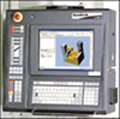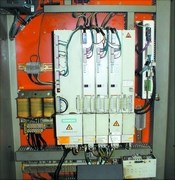CNC Retrofit Improves Production And Saves Money
Brooklyn Technical Services selected the Siemens Sinumerik 802D panel-based control system for this creep feed grinding application because it provides a lot of value for the customer in a compact package.
The start of 2005 was unlucky for the Honeywell Engine and Systems facility in Greer, South Carolina, when its three creep-feed grinders controlled by PLCs with positioning capability had become prone to failures and crashes. As a result, two of the machines were no longer in use. The facility turned to Brooklyn Technical Services (Brooklyn, Connecticut) after deciding to retrofit all the machines with CNCs. Brooklyn Technical Services specializes in the retrofit and rebuild of creep-feed grinders and roll grinders.
“My objective here was to devise a cost-effective retrofit solution that would be easy for the machine operators to use,” explains Brooklyn Technical Services Owner Cliff Divine. He selected the Sinumerik 802D panel-based control system from Siemens Machine Tool Business (Elk Grove Village, Illinois) for this grinding application, because he says it provides a lot of value for the customer in a compact package. “Brooklyn Technical Services was one of the first retrofitters to use the 802D in a grinding application, and we had excellent results for our customers.”
Featured Content
Not only did the machines at Honeywell begin to work properly after the retrofit, but they also proved to be cost-effective. Because the machines already had Siemens analog servodrives and motor packages from a previous job Mr. Divine completed at Honeywell, the facility was able to save a significant amount of money. “By using a Siemens ADI4 interface board, we were able to use the existing servodrive and motors,” Mr. Divine says.
Brooklyn Technical Services initially developed a series of custom dressing and grinding cycles for this application. The cycles use a sequence of permanently definable user variables. In this case, the retrofitter was able to assign a series of plain text commands into the user data table. The value that the operator enters is stored until the value is changed by the operator, which, Mr. Divine notes, is an advantage over other controls that require entering this information at each cycle use.
Also, by using plain text, the operators are more readily able to recognize the use of each variable. “Who knows what the programmer has the user variable R20 designated for, or what letter ‘B’ signifies when in one cycle it might mean grinding feed rate and in another cycle it means dress amount?” Mr. Divine explains. “Simple language such as grinding feed rate, wheel surface speed and dress amount are much easier for the operator to understand. Also, there are fewer chances for error.”
He adds that Brooklyn Technical Services is able to place checks within the part programs to verify that the values entered by the operators fall within a specific range, thus preventing crashes and scrapped parts.
The Sinumerik 802D combines all CNC, PLC, HMI and communication tasks in the panel control unit (PCU). This maintenance-free PCU integrates PC-based hardware and the Profibus interface for the drives and the I/O modules. The CNC can control up to four digital feed axes, and the spindle is also fully controlled by the PCU. In addition to the digital interface via Profibus, it also offers an analog interface for the spindle.
In Honeywell’s application, the CNC controls the axis and spindle movements of the creep-feed grinder. The programs are stored in the machine’s memory, and the CNC is linked to the host DNC at the customer location. “Because the user data are all plain text, and the values stored remain after each cycle, the operators find the setup to be very easy and fast,” Mr. Divine explains. “We provided setup programs that allowed the operators to jog the grinding wheel to the part, and automatically calculate and load the fixture offsets. Our initial dress program sets the wheel diameter and pre-dresses the form into the wheel without operator intervention. In fact, one of the night shift operators told us it was the easiest machine he’d ever run.”
Mr. Divine further notes that the CNC packages are adaptable to his machine needs. “Through the use of Siemens machine data tables, an integrator can easily enter the pertinent data on the machine. The manufacturer has already integrated most of the components. Through the use of function blocks in the PLC, there is little needed to set up the machine control panel or the setup panel—even the display is predefined.” This built-in integration, he adds, has saved him hundreds of hours of integration time.
Ease of use is only one of the many benefits the retrofit offers the machines at Honeywell. They are also much more efficient than they were prior to the retrofit. The machines have been running for almost a year since the retrofit, and not a single crash or machine failure has been reported. “It’s the best grinder I ever saw for $35,000 (the cost of the retrofit),” says Honeywell Manufacturing Engineer Dan Hicks.
The support from Siemens has also been impressive, according to Mr. Divine. “The people in the controls applications department are some of the best I’ve ever encountered. I’ve been working with CNCs on machine tools for more than 30 years and have dealt with all the major control suppliers in the industry. I chose to work exclusively with Siemens some years ago because of their application engineers. Often times, these engineers have been able to satisfy my requirements when other CNC suppliers said they could not.” He adds that he couldn’t be more satisfied with the results he has seen from the products and the people at Siemens.
RELATED CONTENT
-
Program a Robot with your Machine’s CNC
A new function in popular controls enables shops to program machine-tending robots using familiar CNC G codes.
-
Let’s Talk About Less Machining Chatter
For some turning work, unwanted harmonics can cause chatter and poor surface finishes. A new CNC software capability can automatically compensate for this.
-
Monitoring Perishable Tools On Automatics
Monitoring tool wear is an essential component to getting greater productivity and lower costs from a machine tool.








